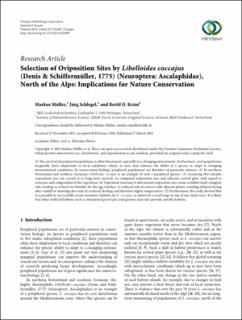Please use this identifier to cite or link to this item:
https://doi.org/10.21256/zhaw-3630| Publication type: | Article in scientific journal |
| Type of review: | Peer review (publication) |
| Title: | Selection of oviposition sites by libelloides coccajus (Denis & Schiffermüller, 1775) (Neuroptera: Ascalaphidae), north of the Alps : implications for nature conservation |
| Authors: | Müller, Markus Schlegel, Jürg Krüsi, Bertil |
| DOI: | 10.21256/zhaw-3630 10.1155/2014/542489 |
| Published in: | Journal of Insects |
| Volume(Issue): | 2014 |
| Issue: | 542489 |
| Issue Date: | 2014 |
| Publisher / Ed. Institution: | Hindawi |
| ISSN: | 2356-7465 2314-6478 |
| Language: | English |
| Subjects: | IOEK; UPLA |
| Subject (DDC): | 577: Ecology 590: Animals (Zoology) |
| Abstract: | The survival of peripheral populations is often threatened, especially in a changing environment. Furthermore, such populations frequently show adaptations to local conditions which, in turn, may enhance the ability of a species to adapt to changing environmental conditions. In conservation biology, peripheral populations are therefore of particular interest. In northern Switzerland and southern Germany, Libelloides coccajus is an example of such a peripheral species. Assuming that suitable oviposition sites are crucial to its long-term survival, we compared oviposition sites and adjacent control plots with regard to structure and composition of the vegetation. Vegetation structure at and around oviposition sites seems to follow fairly stringent rules leading to at least two benefits for the egg clutches: (i) reduced risk of contact with adjacent plants, avoiding delayed drying after rainfall or morning dew and (ii) reduced shading and therefore higher temperatures. Furthermore, the study showed that it is possible to successfully create secondary habitats for L. coccajus, as shown by a road verge in one of our study areas. It is likely that other artificial habitats such as abandoned gravel pits and quarries may also provide suitable habitats. |
| URI: | https://digitalcollection.zhaw.ch/handle/11475/5768 |
| Fulltext version: | Published version |
| License (according to publishing contract): | CC BY 3.0: Attribution 3.0 Unported |
| Departement: | Life Sciences and Facility Management |
| Organisational Unit: | Institute of Natural Resource Sciences (IUNR) |
| Appears in collections: | Publikationen Life Sciences und Facility Management |
Files in This Item:
| File | Description | Size | Format | |
|---|---|---|---|---|
| L.coccajus_J of Insects_2014.pdf | 2.87 MB | Adobe PDF |  View/Open |
Show full item record
Müller, M., Schlegel, J., & Krüsi, B. (2014). Selection of oviposition sites by libelloides coccajus (Denis & Schiffermüller, 1775) (Neuroptera: Ascalaphidae), north of the Alps : implications for nature conservation. Journal of Insects, 2014(542489). https://doi.org/10.21256/zhaw-3630
Müller, M., Schlegel, J. and Krüsi, B. (2014) ‘Selection of oviposition sites by libelloides coccajus (Denis & Schiffermüller, 1775) (Neuroptera: Ascalaphidae), north of the Alps : implications for nature conservation’, Journal of Insects, 2014(542489). Available at: https://doi.org/10.21256/zhaw-3630.
M. Müller, J. Schlegel, and B. Krüsi, “Selection of oviposition sites by libelloides coccajus (Denis & Schiffermüller, 1775) (Neuroptera: Ascalaphidae), north of the Alps : implications for nature conservation,” Journal of Insects, vol. 2014, no. 542489, 2014, doi: 10.21256/zhaw-3630.
MÜLLER, Markus, Jürg SCHLEGEL und Bertil KRÜSI, 2014. Selection of oviposition sites by libelloides coccajus (Denis & Schiffermüller, 1775) (Neuroptera: Ascalaphidae), north of the Alps : implications for nature conservation. Journal of Insects. 2014. Bd. 2014, Nr. 542489. DOI 10.21256/zhaw-3630
Müller, Markus, Jürg Schlegel, and Bertil Krüsi. 2014. “Selection of Oviposition Sites by Libelloides Coccajus (Denis & Schiffermüller, 1775) (Neuroptera: Ascalaphidae), North of the Alps : Implications for Nature Conservation.” Journal of Insects 2014 (542489). https://doi.org/10.21256/zhaw-3630.
Müller, Markus, et al. “Selection of Oviposition Sites by Libelloides Coccajus (Denis & Schiffermüller, 1775) (Neuroptera: Ascalaphidae), North of the Alps : Implications for Nature Conservation.” Journal of Insects, vol. 2014, no. 542489, 2014, https://doi.org/10.21256/zhaw-3630.
Items in DSpace are protected by copyright, with all rights reserved, unless otherwise indicated.